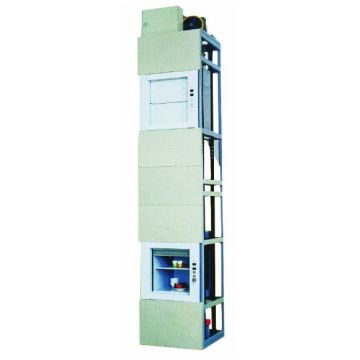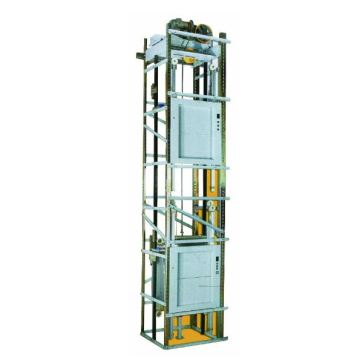A dumbwaiter is a small
freight elevator or lift intended to carry objects rather than people.
Dumbwaiters found within modern structures, including both commercial, public
and private buildings, are often connected between multiple floors. When
installed in restaurants, schools, kindergartens, hospitals, retirement homes
or in private homes, the lifts generally terminate in a kitchen.
The term seems to have been
popularized in the United States in the 1840s, after the model of earlier
"dumbwaiters" now known as serving trays and lazy Susans. The
mechanical dumbwaiter was invented by George W. Cannon, a New York City
inventor. Cannon first filed for the patent of a brake system (US Patent no.
260776) that could be used for a dumbwaiter on January 6, 1883. Cannon later
filed for the patent on the mechanical dumbwaiter (US Patent No. 361268) on
February 17, 1887.Cannon reportedly generated a vast amount of royalties from
the dumbwaiter patents until his death in 1897.
A simple dumbwaiter is a movable
frame in a shaft, dropped by a rope on a pulley, guided by rails; most
dumbwaiters have a shaft, cart, and capacity smaller than those of passenger
elevators, usually 45 to 450 kg (100 to 1000 lbs.) Before electric
motors were added in the 1920s, dumbwaiters were controlled manually by ropes
on pulleys.
Early 20th-century codes
sometimes required fireproof dumbwaiter walls and self-closing fireproof doors
and mention features such as buttons to control movement between floors and
locks on doors preventing them from opening unless the cart is stopped at that
floor. Dumbwaiter Lifts in London were extremely popular in the houses of the
rich and privileged. Maids would use them to deliver laundry to the laundry
room from different rooms in the house. They negated the need to carry handfuls
of dirty washing through the house, saving time and preventing injury.
A legal complaint about a
Manhattan restaurant's dumbwaiter in 1915, which also mentions that food orders
are shouted up and down the shaft, describes its operation and limitations as
follows:
[There is] ... great play between
the cart of the dumb-waiter and the guides on which it runs, with the result
that the running of the cart is accompanied by a loud noise. The rope which
operates the cart of the dumb-waiter runs in a wheel with a very shallow
groove, so that the rope is liable to and does at times slip off. ... The cart
has no shock absorbers at the top, so that when it strikes the top of the shaft
or wheel there is a loud report. ... [T]he ropes of the dumb-waiter strike such
wall at frequent intervals with a loud report. ... [T]he dumb-waiter is often
negligently operated, by running it faster than necessary, and by letting it go
down with a sudden fall.
More recent dumbwaiters can be
more sophisticated, using electric motors, automatic control systems, and
custom freight containers of other kinds of elevators. Recently constructed
book lifts in libraries and mail or other freight transports in office towers
may be larger than many dumbwaiters in public restaurants and private homes,
supporting loads as heavy as 450 kg (990lbs)


 Contact Now
Contact Now

